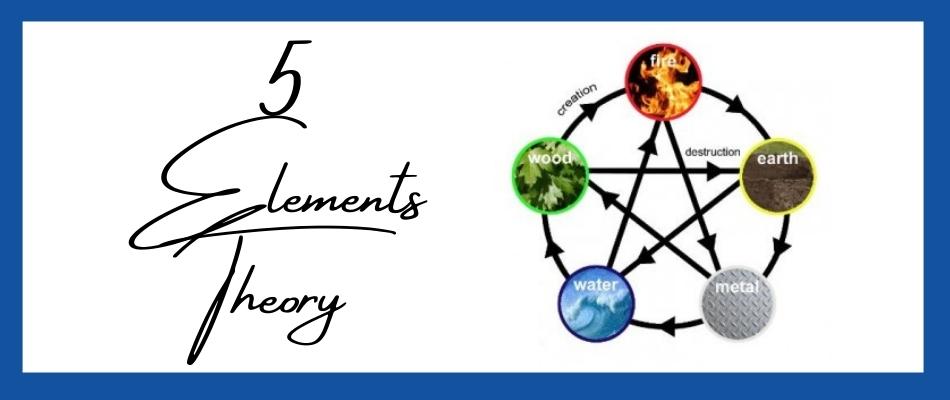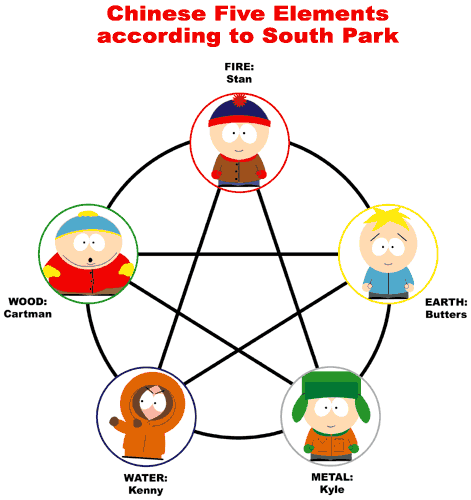There is an esoteric side of tai chi that dips in and out of the Tao, the I-Ching, yin-yang theory, and the ancient Chinese five elements theory. Are these terms new to you or confusing? Join the club. This is an amazingly large body of knowledge and very few practitioners have completely wrapped their mind around all of these topics. Unless coming from a philosophical background or having acupuncture knowledge, nearly no new practitioners have this stuff figured out. It can be intimidating but doesn’t have to be.
Five Elements Theory is a Chinese philosophy dating back to the 2nd-1st century BCE used for describing the relationship of things and order that events transpire. It is central to Chinese Medicine for diagnosing ailments and can be used for assessing situations and making better decisions.
Gaining philosophical understanding and improving their lives is a huge reason why people begin tai chi. The key is understanding just enough about the philosophy to see how to apply it to our daily lives and tai chi practice. That way we advance as practitioners and improve our life. That’s what this essay is about. We are going to explain 5 Element Theory, point you to some resources, and show you how you can use it like a diagnostic tool to make better decisions and improve areas of your life.
Exploring the philosophy and medical history that contribute to tai chi aids in understanding of how we move.
What is Five Elements Theory?
Five Elements Theory describes five phases that events and systems transitions through. It is most notably explained in its relationship to nature and the transition through five natural phenomena: wood, fire, earth, metal, and water.
The word for five elements in Chinese is Wuxing (五行) where Wu means 5 and Xing is most often translated as “elements.” I think that this is unfortunate because it limits our understanding of it from a western perspective. The character Xing (行) is used in words like: moving planet, row, conduct, behavior, and even adjectives like temporary. Five Phases is also used and I like that way better because it captures all of the possibilities of using Five Element Theory without only boiling it down to natural elements.
Forgive my wordiness here but to really understand just what is five elements theory two words or two characters doesn’t cut it. A better definition (e.g., understanding) of Five Elements Theory would be that it describes:
- The transitions in life where one thing leads to another (phases)
- The fact that things happen in an order (row)
- That you are never in a permanent state but always transitioning (temporary)
- A fickleness. You can go one direction to build/create or go the other direction to reduce/destroy (behavior)
- The behavior of everything in existence (moving planet)
How’s that for a philosophical theory! Pretty daunting isn’t it? Let’s break it down further so we can get back to talking about the elements from a place we can see how to benefit from it.
Chinese Five Element Theory Phases and Cycles
Five Element Theory describes two cycles, one the builds up and one that reduces or breaks down. This is where the metaphor using the elements gives us a better understanding of this concept. For example:
Wood feeds fire – builds it up BUT Fire burns up wood – reduces it.
Then it goes on to describe five phases that are the transition between each state:
Phases of the Five Elements Theory
| Phase | Explanation | Example |
|---|---|---|
| Inter-regulating | Something stabilizes something else | Earthen walls direct water, fire reshapes metal |
| Over-acting | Something is overbearing (too much) | Earth dams up water, Water puts our fire |
| Counter-acting | Something inhibits something else | Metal made dull by wood, wood rotted by earth |
| Inter-promoting | Something has a positive effect on something else | Fire produces fertile earth, water feeds wood |
| Weakening | Something destabilizes something else | Fire burns wood, Water rusts metal |
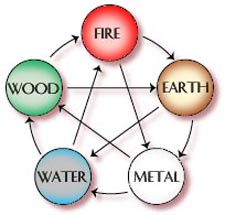
This is most beautifully illustrated in the five elements symbols you see which show the transition between one state or another and the order. If you transition in one direction you are feeding the next. If you are transitioning backwards you are reducing the next. The additional arrows across the center of the diagram indicate what reduction or destruction.
Okay, that’s the basics and that’s all we need to understand in order to benefit from thinking about the five elements and applying it to other areas of our life. Here are the steps and questions that we can ask to identify how to improve a situation.
- We identify that we have a problem.
- What is causing the problem?
- Is something restricting or stopping the change from happening?
- Is there someone or something that we could add to the situation to make it better.
How to Apply the Five Element Theory to Your Personal Life
As you can guess, applying the Five Element Theory to the problems in your life can be complex and I feel is best left to the experts. There are a few great resources online like tests you can take and books you can read. The general idea still holds true though. Identify where you are or what you are not happy with and then work to reduce or increase the influences on the problem.
This is the part that makes Five Element Theory VERY different from Western though. We are not focusing on the problem only, we are researching what 1) is influencing the problem for better or worse, and 2) what the next stage will look like as you transition out of or away from your problem.
Five Elements Theory Chart
Fpr starters, download or print this 5 Elements Chart for easy reference.
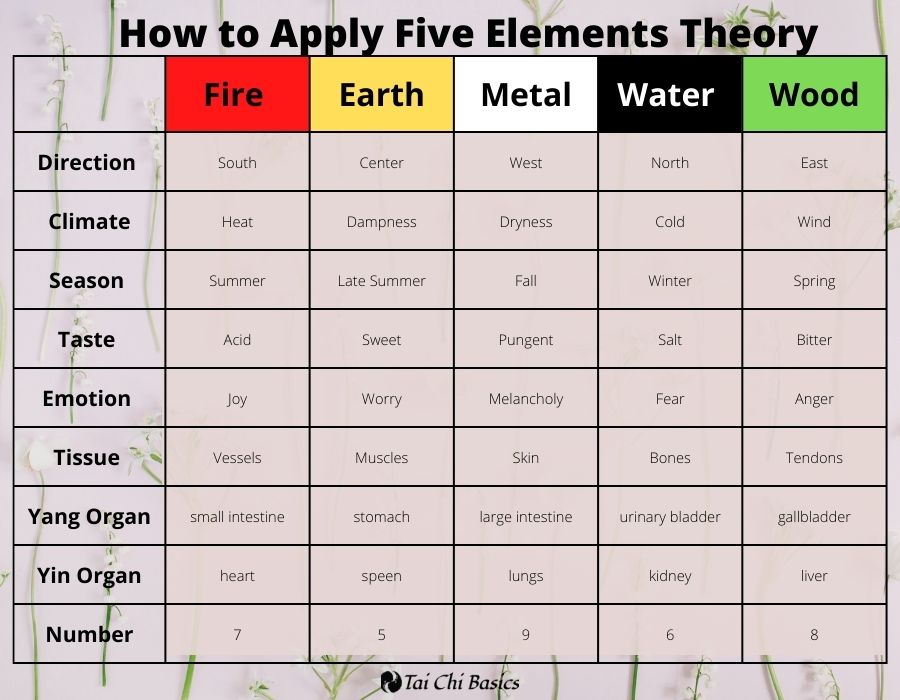
Five Elements Theory Personality Test
For things that are personal or even psychological, you have to first identify which elements or phases of the five elements theory you most relate to. There is a group that focuses exclusively on the relationship between this philosophy and psychology and emotions. They made a five elements theory personalitt test which has a short quiz to find out what your element is which is kind of fun.
Books on Five Element Theory
There are a handful of really good audiobooks and books on Five Element Theory online that make the topic interesting and learnable. Have a look at these:
The Five Elements: Understand Yourself and Enhance Your Relationships with the Wisdom of the World’s Oldest Personality Type System
Designing the Mind: The Principles of Psychitecture
The Tao of Trauma: A Practitioner’s Guide for Integrating Five Element Theory and Trauma Treatment
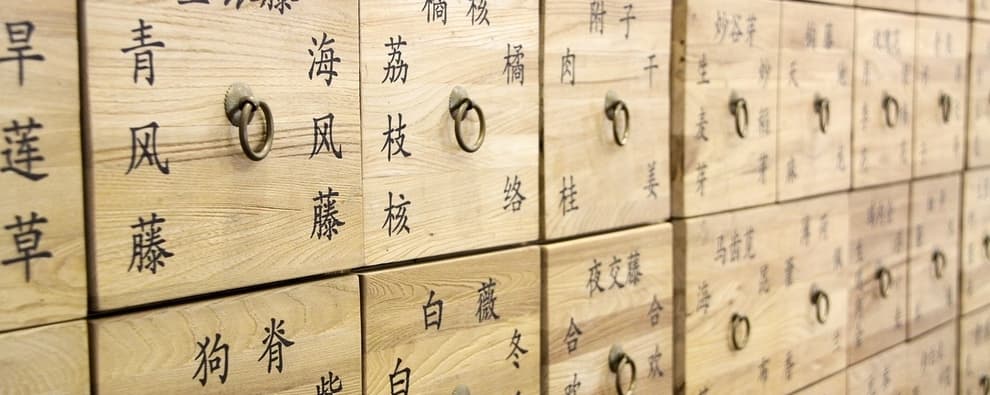
How is Five Elements Theory Used in Chinese Medicine?
A visit to a TCM doctor begins much the same as you would expect from any doctor. You wait! (just kidding, not really..) You then explain your symptoms and undergo an evaluation. In Traditional Chinese Medicine, they can use the Five Element theory to guide our diagnosis.
Based on your complaints or symptoms, an organ is identified which is then tonified or depleted based on having too much or too little of the correct energy. This is typically accomplished through massage, qi gong, herbs, acupuncture, or suggestions for food. The goal is to bring everything back into harmony.
Let’s talk through an example:
Two primary forces (yin and yang) interact in the body. Most people would accept that if your body is out of balance, you are less strong, healthy, and mentally alert. (OK, I’m with you).
What does the Five Elements Theory do? It explains the relationship between the organs, the way energy gets to the organs (meridians), and how the energy (chi) primarily originates from the kidneys. (Sure, the organs each have a job, this job needs energy, the kidneys make the energy and send it along the meridian highways, check!).
Why is this chi energy largely associated with the kidneys? The kidneys are said to hold opposing fire and water energy. An imbalance here trickles down to affect other organs depending on the imbalance. In practical terms, the blood is filtered by the kidneys sending fresh blood back in and toxins out. (Still with ya. A happy kidney factory means clean, well fueled organs).
How does this relate to health? All poor health conditions are due to something that an organ is not doing. For example, bronchitis can be attributed to weak lungs. Equally so, emotional difficulties are tied to organs and can lead to nervous system imbalances. (Whoa, so I can affect the two sides of this coin? 1) My eating, liquid intake, and exercise affects what arrives at the kidneys. 2) My activities affect how the kidneys function.
Tai Chi and Five Elements Theory
This finally leads us to talking about the relationship between tai chi and the ancient Chinese theory of five elements. The movements of tai chi are designed to restore balance to the body. So what ever imbalance you are experiencing or whatever you are prescribed, tai chi will move you in that direction.
How tai chi fits into five elements theory
Much of the meditation and concentration involves focusing on your belly where the dantien and mingmen are located. These directly nourish the nearby kidneys. The movements of taichi rotate and massage the center. These activities balance the kidneys. The kidneys then balance the rest of the system. (Tai chi is designed in-part to nourish and support the activity of the kidneys. 2500 years of research can’t be wrong I guess).
Some practitioners focus on strengthening a certain meridian and organ based on what season it is. This makes a lot of sense and is quite intriguing.
| Season | Element | Orgin | Why |
|---|---|---|---|
| Winter | Water | Kidneys,Bladder | Generate energy to other organs to stave off fatigue, coldness, and weight gain. |
| Spring | Wood | Liver,Gall Bladder | Increase strength and stamina for coming summer activity and processing of summer foods |
| Summer | Fire | Heart,Sm. Intestine | Stabilize blood flow, blood supply, clarity and process foods of summer. |
| Late Summer | Earth | Spleen,Stomach | Obtain energy from the activities and foods of harvest. |
| Fall | Metal | Lungs,Lg. Intestine | Strengthen the lungs before the winter months. |
Practitioners also link the directions of movements with the five elements to describe the 1) power that is supplied to the movement and to 2) identify which movements can be performed to alleviate health concerns.
| Earth | On Guard, Centering |
| Wood | Retreat |
| Gold | Advance |
| Fire | Move to the Right |
| Water | Move to the Left |
Don’t get overwhelmed by the technical aspects of five elements theory
Yes five elements theory is complex but take away the pieces that you understand and let the rest sink in over time. Know that when you practice and your movements improve, the direct impact on your health can be felt. We can learn and remain light-hearted. Here is a funny and perfect example to keep you grounded. Chinese Five Elements According to South Park
Chinese Five Element Theory PDF Examples from Real Life
I think it’s fascinating that once you understand the rough framework of five elements theory it gives you a structure to better understand and make change in what you care about. I wanted to end here with a couple examples to show you how others have used the ancient Chinese theory of five elements to improve something they deeply care about.
Five Element Theory PDF on Sustainability: Trying to make suggestions to improve the environment are difficult because several decisions or changes have to happen simultaneously to have an impact. In this five element theory pdf, two Swedish workers in the field of sustainability used this framework to identify five areas that needed to be acted upon at once to cause changes to the environment. Sustainability application.
Five Element Theory PDF on Psychology: This is kind of neat. Three Korean researchers used the this idea to frame out differences in personality with the hopes of creating a framework to understand a person’s emotions so that they can be helped counseled through difficult times. Psychology application.
As always, tai chi is like a classroom where we learn something that benefits us. It is most powerful when we get to the level of seeing how what we learn from the tai chi form can positively influence our life.
More on Eastern concepts and principles related to tai chi: If you were interested in 5 Elements Theory then you also need to learn about Yin Yang Theory because the two go hand-in-hand. I have also written about Chinese symbolism, the tai chi concept of Substantial-Unsubstantial, and the tai chi principle behind the number nine.


